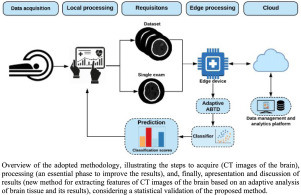Engineering Applications of Artificial Intelligence ( IF 8 ) Pub Date : 2020-02-28 , DOI: 10.1016/j.engappai.2020.103585 Francisco F.X. Vasconcelos , Róger M. Sarmento , Pedro P. Rebouças Filho , Victor Hugo C. de Albuquerque

|
Strokes are one of the leading causes of death in the world. Despite the high mortality rate, chances of recovery are high when an accurate diagnosis is made quickly, and appropriate treatment is provided. Several types of neuroimaging techniques are used to detect strokes, and computed tomography (CT) and magnetic resonance imaging are the main ones. Although magnetic resonance imaging shows clearer results, CT is, in most cases, the most viable alternative, due to the reduced examination time and low cost. Several computer-aided diagnostic systems have been developed in recent years with a focus on the Internet of Things (IoT). These systems, which establish rapid communication between the IoT devices, provide greater integration between specialists and patients, and consequently, a better medical follow up. However, stroke detection and classification techniques in IoT devices require that these methods developed methods have low computational and low storage costs. Thus, Edge computing devices have been attracting attention for their excellent processing capabilities, providing a layer between the IoT device and the cloud. This work proposes a new feature extractor for brain CT images based on an Adaptive Analysis of Brain Tissue Densities. The proposed method presented promising results of accuracy and F1-score, reaching 98.13% and 97.83%, respectively, surpassing several state-of-the-art methods. Furthermore, the proposed method presents low computational cost, with an average extraction time of 0.087s per image, and is, thus, a viable option for integration in IoT and Edge Computing devices, by providing rapid detection and classification of strokes.
中文翻译:

人工智能技术助力边缘云架构进行大脑CT图像分析
中风是世界上主要的死亡原因之一。尽管死亡率很高,但如果迅速做出准确的诊断并提供适当的治疗,恢复的机会就很高。几种类型的神经成像技术可用于检测中风,而计算机断层扫描(CT)和磁共振成像是主要的技术。尽管磁共振成像显示出更清晰的结果,但由于检查时间减少且成本较低,因此在大多数情况下,CT是最可行的选择。近年来,已经开发了几种计算机辅助诊断系统,重点放在物联网(IoT)上。这些系统在IoT设备之间建立快速通信,在专家和患者之间提供了更大的集成,因此可以更好地进行医疗跟进。然而,物联网设备中的笔触检测和分类技术要求这些方法开发的方法具有较低的计算量和较低的存储成本。因此,边缘计算设备以其出色的处理能力而备受关注,在IoT设备和云之间提供了一层。这项工作提出了一种新的基于脑组织密度的自适应分析的脑部CT图像特征提取器。该方法的准确性和F1得分均达到了有希望的结果,分别达到98.13%和97.83%,超过了几种最新方法。此外,所提出的方法具有较低的计算成本,每张图像的平均提取时间为0.087s,因此通过提供笔画的快速检测和分类,是在IoT和边缘计算设备中集成的可行选择。


























 京公网安备 11010802027423号
京公网安备 11010802027423号